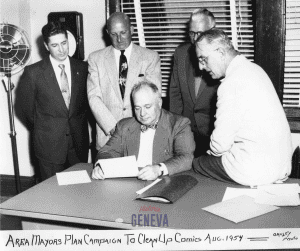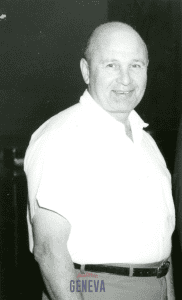Objectionable Comics or Freedom of the Press
By Becky Chapin, Archivist
The war over comic books began almost as soon as (American-style) comic books came into existence in the 1930s. By the 1940s, comic book burnings were not infrequent and censorship laws in New York State started appearing by 1948. The Association of Comics Magazine Publishers was formed the same year but ultimately failed due to a lack of participation by publishers. And in the 1950s, the Senate Judiciary Committee’s Subcommittee to Investigate Juvenile Delinquency was formed to hear from child psychologists, comic book publishers, and cartoonists about the possibility of government regulation.
Around the Geneva area, municipalities struggled to figure out why juvenile delinquency was on the rise, but most blamed “indecent” comic books. As a response, the Four-County Mayors Association was formed in 1954, months after the Senate Subcommittee completed their investigation.
The association first heard from John Lomenzo, the Monroe County American Legion vice commander and “spark plug” of a Rochester drive on indecent comics. He warned members that censorship was not the answer to objectionable comics; that it had been tried for the last ten years nationally, and on a state and local level but had been a complete failure.
Despite his warnings, Geneva Mayor W. Erle Rogers presented a list of acceptable comic books drawn up by a national group – only 120 books out of over 400 on the shelves. The Association heard from the owner of the Seneca News Agency, Louis Budgar, who said “No dealer with whom the Seneca News Agency does business has to sell any magazine that he, the dealer, does not want to put on his stand.”
In another meeting, Budgar told the Association that the new Comics Code Authority had come out with the “Seal of Approval.” Censors funded by the comic book industry enforced rules about what was acceptable content. Only comics that passed a pre-publication review would carry this seal. Budgar said, “We will not handle any comic books that do not carry the approval seal.”
A question came up about controlling the contents of other books and Budgar felt this was entering the realm of censorship. He asked, “Who will do the censoring?” and “Who is qualified to do it?” It was tampering with freedom of the press and with the freedom of adult Americans to make their own choices, he felt. “What one man might object to another might like,” he asserted, “and who is to say who is right?”
Budgar disagreed with such a level of censorship, that it was up to the publishers themselves to clean up their publications. The Mayors Association maintained local programs to encourage parents to look at what their children were reading. One program was the distribution of flyers with household milk deliveries (mainly in Penn Yan) about the danger behind reading the “wrong” type of material and its possible tie to juvenile delinquency.
Two years later, in December 1957, Louis Budgar was arrested on several counts of distribution of indecent articles by means of tie-in sales. It was alleged by Louis Guard, of Guard’s Pharmacy, that Budgar forced Guard to display certain magazines which Guard considered lewd and lascivious as a condition to receive other publications.
This was in violation of the State penal code, Section 1141-b (which was entitled “Distribution of indecent articles; tie-in sales “and is now defunct as far as I can tell). Budgar then refused to deliver any more material distributed by his agency and his employees removed all publications and the display rack from the pharmacy.
The core of the case was that the question was not whether these books were lewd or lascivious; rather whether the publications could be reasonably believed by Guard to be lewd or lascivious. It was believed to be the first case of its kind to be tried in the area.

Area Mayors Plan Campaign to Clean up Comics, August 1954. Pictured in center is Geneva Mayor W Erle Rogers, to the right is Geneva born, Penn Yan Mayor Lewis Gracey.
A motion was granted to move the case out of city court so it could be prosecuted by indictment. Additionally, Budgar’s attorney Walter Putziger indicated he intended to challenge the constitutionality of Section 1141-b which could not be done on the city level. The case was brought to a grand jury who indicted Budgar on 32 counts of distribution and possessing obscene literature. Budgar entered an innocent plea.
The hearing was postponed several times including once when District Attorney M. Maurice Chacchia of Geneva told the judge there had been “new developments in the case which I feel require further investigation.” Chacchia was working with Budgar to remove certain objectionable magazines from present and future sales to prevent court interference.
Budgar proposed 25 publications he would remove from distribution, abiding by “a code which is being developed by the newly organized National Distributors of Magazines Board of Review, Inc.”
In October 1958, Judge Carrollton A Roberts dropped the case against Budgar as he voluntarily removed some magazines that were deemed objectionable. However, in the record, the defense asserted that it did not concede that any of the magazines mentioned were obscene.
DA Chacchia expressed his opinion that the incident was more about a clash of personalities than the problem of objectionable material :
The main thing is the control of the dissemination of such periodicals and not entering into or trying to referee a dispute which in the light of a complete investigation reveals a clash of personalities…and I don’t hesitate to express my opinion that the clash of personalities is such as to in and of itself raise a reasonable doubt in the minds of the trial jury as to the guilt or innocence of the accused.
In his original discussion with the Mayors Association about advising against a drive against indecent comic books, John Lomenzo said “You can’t tell people what to do. Rochester tried it and it fell flat.”
I discovered Louis Budgar’s story while doing research for my Glenwood Cemetery tour in 2024 . This is an expanded version from my tour.
Further Reading
History of Comics Censorship Part 1
This article was brought to you in part by our supporters. Be our partner in telling Geneva’s stories by becoming a Historic Geneva supporter.

